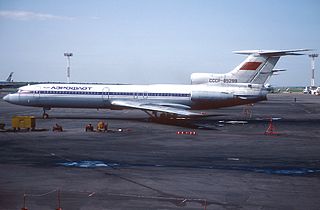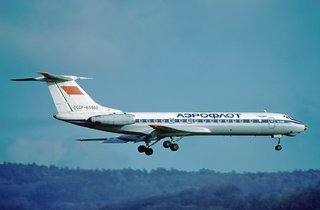
The Tupolev Tu-104 is a medium-range, narrow-body, twin turbojet-powered Soviet airliner. It was the second to enter regular service, behind the British de Havilland Comet and was the only jetliner operating in the world from 1956 to 1958, when the British jetliner was grounded due to safety concerns.

The Tupolev Tu-124 is a 56-passenger short-range twin-jet airliner built in the Soviet Union. It was the Soviet Union's first operational airliner powered by turbofan engines.

Aeroflot Flight 366, also known as the Miracle on the Neva, was a water landing by a Tupolev Tu-124 of the Soviet state airline Aeroflot. The aircraft took off from Tallinn-Ülemiste Airport (TLL) at 08:55 on 21 August 1963 with 45 passengers and 7 crew on board. The aircraft was built in 1962 and was scheduled to fly to Moscow–Vnukovo (VKO) under the command of 27-year-old captain Victor Mostovoy. After takeoff the nose gear did not retract. Ground control diverted the flight to Leningrad (LED) – because of fog at Tallinn.

Aeroflot-Nord Flight 821 was a scheduled domestic passenger flight operated by Aeroflot-Nord in a service agreement with Aeroflot and as its subsidiary. On 14 September 2008, the aircraft operating the flight crashed on approach to Perm International Airport at 5:10 local time (UTC+06). All 82 passengers and six crew members were killed. Among the passengers who were killed was Russian Colonel General Gennady Troshev, an adviser to the President of Russia who had been the commander of the North Caucasus Military District during the Second Chechen War. A section of the Trans-Siberian Railway was damaged by the crash. Flight 821 is the deadliest accident involving a Boeing 737-500, surpassing the 1993 crash of Asiana Airlines Flight 733, and was the second-deadliest aviation accident of 2008, behind Spanair Flight 5022.

Aeroflot Flight 3352 was a regularly scheduled Aeroflot domestic flight in the Soviet Union from Krasnodar to Novosibirsk, with an intermediate landing in Omsk. While landing at Omsk Airport on Thursday, 11 October 1984, the aircraft crashed into maintenance vehicles on the runway, killing 174 people on board and four on the ground. While a chain of mistakes in airport operations contributed to the accident, its major cause was an air traffic controller falling asleep on duty.

Aeroflot Flight 4225 was a Tupolev Tu-154B-2 on a scheduled domestic passenger flight from Alma-Ata Airport to Simferopol Airport on 8 July 1980. The aircraft had reached an altitude of no more than 500 feet when the airspeed suddenly dropped because of thermal currents it encountered during the climb out. This caused the airplane to stall less than 5 kilometres from the airport, crash and catch fire, killing all 156 passengers and 10 crew on board. To date, it remains the deadliest aviation accident in Kazakhstan. At the time, the crash was the deadliest involving a Tupolev Tu-154 until Aeroflot Flight 3352 crashed in 1984, killing 178 people.

Aeroflot Flight 964 was a flight operated by Aeroflot from Kutaisi Airport, Georgia to Domodedovo Airport, Moscow, Russian SFSR. On 13 October 1973, the Tupolev Tu-104 operating on the route crashed during its approach to Moscow, killing all 122 passengers and crew on board. It remains the deadliest accident involving a Tupolev Tu-104.

Aeroflot Flight 3932 was a flight operated by Aeroflot from Sverdlovsk-Koltsovo to Omsk Tsentralny Airport. On 30 September 1973, the Tupolev Tu-104 operating the route crashed shortly after takeoff from Sverdlovsk, killing all 108 passengers and crew on board.

Aeroflot Flight 5463 was a Soviet domestic passenger flight from Chelyabinsk to Almaty which crashed on 30 August 1983 while approaching Almaty. The Tupolev Tu-134A collided with the western slope of Dolan Mountain at an altitude of 690 m (2,260 ft). As a result of the accident, all ninety people on board were killed. Crew error was cited as the cause of the accident.

Aeroflot Flight 3519 was a scheduled flight, operated by a Tupolev Tu-154B-2 that crashed on December 23, 1984 due to an engine failure, 110 occupants were killed; one passenger had survived the accident.

Aeroflot Flight 3603 was a Tupolev Tu-154 operating a scheduled domestic passenger flight from Krasnoyarsk to Noril'sk, both in the Soviet Union, that crashed while attempting to land on 17 November 1981. Of the 167 passengers and crew on board, 99 were killed in the accident.

Aeroflot Flight 99 was a Tupolev Tu-124 operating a scheduled domestic passenger flight from Leningrad to Murmansk, both in the Soviet Union, which crashed while attempting to land on 11 November 1965. Of the 64 passengers and crew on board, 32 were killed in the accident, and many of the survivors sustained injuries.

Aeroflot Flight 065 was a scheduled passenger flight operated by the International Civil Aviation Directorate division of Aeroflot. On 17 February 1966 at 1:38 am local time a Tupolev Tu-114 crashed during take-off from Sheremetyevo International Airport in Moscow, killing 21 of the 47 passengers and 19 crew members on board. This was the only fatal incident involving a Tu-114. A committee investigating the accident found that the crash was due to multiple crew and ATC failures.

Aeroflot Flight 1912 was a scheduled domestic Aeroflot passenger flight on the Odessa-Kiev (Kyiv)-Chelyabinsk-Novosibirsk-Irkutsk-Khabarovsk-Vladivostok route that crashed on 25 July 1971, making a hard landing at Irkutsk Airport. It touched down 150 metres (490 ft) short of the runway, breaking the left wing and catching fire. Of the 126 people on board the aircraft, 29 survived.

Aeroflot Flight 109 was a scheduled domestic passenger flight from Moscow to Chita with stopovers in Chelyabinsk, Novosibirsk, and Irkutsk. On the final leg of the route on 18 May 1973 a terrorist hijacked the aircraft, demanding to be flown to China; the terrorist's bomb detonated in flight after he was shot by the air marshal. The aircraft broke-up at altitude, killing all 81 on board.

Aeroflot Flight 2808 was a scheduled domestic passenger flight from Mineralnye Vody to Ivanovo, both in Russia, with a stopover in Donetsk, Ukraine on 27 August 1992. While attempting to land at Ivanovo airport, the Tupolev Tu-134 crashed into a group of buildings in the village of Lebyazhy Lug. Investigators determined the cause of the accident was errors made by the crew and the air traffic controller. There were no fatalities on the ground, but all 84 people on board the flight died in the crash.

Aeroflot Flight 5484 was a scheduled domestic passenger flight from Odesa to Kazan with a stopover in Kyiv that experienced loss of control followed by breaking up in the air on 29 August 1979 over the Tambov Oblast, killing all 63 people on board. It remains the deadliest Tu-124 crash and regular passenger services with the Tu-124 were permanently suspended after the accident, but the Tu-124 was still used by the Soviet military after the accident.

Aeroflot Flight 6709 was a Tupolev Tu-154B on a domestic route from Baku to Leningrad on 19 May 1978. While cruising, fuel starvation affected the flow of fuel to the aircraft's three Kuznetsov NK-8 engines, causing the engines to stop. This issue was possibly as a result of poor aircraft design.













